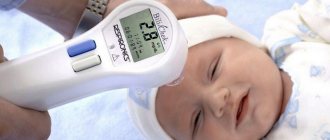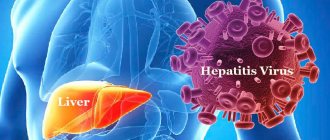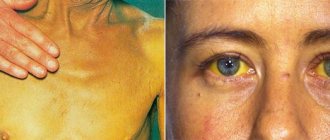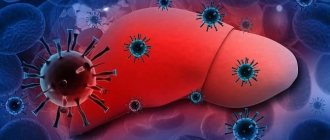Interpretation of markers
| Nosology | Marker | Marker characteristics | Clinical significance |
| Hepatitis A | IgM anti-HAV | class M antibodies to hepatitis A virus | indicate acute infection |
| IgG anti-HAV | class G antibodies to hepatitis A virus | indicate a previous infection or HAV pastinfection, remain in the blood for life | |
| Hepatitis E | IgM anti-HEV | class M antibodies to hepatitis E virus | indicate acute infection |
| IgG anti-HEV | class G antibodies to hepatitis E virus | indicate previous infection or HEV pastinfection | |
| Hepatitis B | HBsAg | HBV surface antigen | marks HBV infection |
| HBeAg | HBV nuclear “e” antigen | indicates HBV replication in hepatocytes, high blood infectivity and high risk of perinatal transmission of the virus | |
| HBcAg | nuclear "core" antigen of HBV | marks HBV replication in hepatocytes, is detected only during morphological examination of liver biopsy specimens and at autopsy, is not detected in free form in the blood | |
| anti-HBc (total) (HBcAb) | total antibodies to HBcAg | an important diagnostic marker, especially with negative results of HBsAg indication, used for retrospective diagnosis of hepatitis B and for unverified hepatitis, HBcAg is determined without division into classes | |
| IgM anti-HBc (HBcAb IgM) | class M antibodies to nuclear antigen | one of the earliest serum markers of hepatitis B, its presence in the blood indicates an acute infection (phase of the disease), in chronic hepatitis B it marks HBV replication and the activity of the process in the liver | |
| anti-HBe (HBeAb) | antibodies to the "e" antigen | may indicate the beginning of the convalescence stage (with the exception of the mutant form of HBV) | |
| anti-HBs (HBsАb) | protective antibodies to HBV surface antigen | indicate a past infection or the presence of post-vaccination antibodies (their protective titer against HBV infection >10 IU/l); detection of antibodies in the first weeks of hepatitis B predicts the development of a hyperimmune variant of fulminant hepatitis B | |
| HBV-DNA | HB virus DNA | marker for HBV presence and replication | |
| Hepatitis D | IgM anti-HDV | class M antibodies to hepatitis D virus | mark HDV replication in the body |
| IgG anti-HDV | class G antibodies to hepatitis virus | indicate possible HDV infection or previous infection | |
| HDAg | HD virus antigen | marker for the presence of HDV in the body | |
| HDV-RNA | HD virus RNA | HDV presence and replication marker | |
| Hepatitis C | anti-HCV IgG | class G antibodies to hepatitis C virus | indicate possible HCV infection or previous infection (determined in screening studies) |
| anti-HCV core IgM | class M antibodies to HCV nuclear proteins | indicate an ongoing infection (acute or chronic in the reactivation phase) | |
| anti-HCV core IgG | class G antibodies to HCV nuclear proteins | indicate HCV infection or previous infection | |
| anti-HCV NS | antibodies to HCV nonstructural proteins | usually found in the chronic stage of HS | |
| HCV-RNA | HS virus RNA | marker of HCV presence and replication | |
| Hepatitis G | HGV-RNA | HS virus RNA | marker for HGV presence and replication |
How to prepare to donate blood
Nutrition plays a major role in preparing for the collection of material for subsequent research. This is due to the fact that after eating, the concentration of individual breakdown products in the blood is adjusted. After the digestion of food is complete, a person’s hormonal levels also change. Blood sampling is performed exclusively on an empty stomach.
Refusal to eat
Patients, due to ignorance of the preparation rules, refuse to eat for several days, but the judgment is erroneous, since prolonged fasting can affect the veracity of the results obtained. If there is no food in the body for two days, the level of bilirubin in the blood increases - a fundamental indicator of laboratory testing.
With the help of the substance, it becomes possible to establish the stage of the disease and the nature of liver damage at the cellular level. With longer abstinence from food, the glucose level decreases and the amount of free fatty acids in the biological material changes. Cholesterol in this case is practically not subject to change.
On the eve of the appointed date, it is recommended to go to bed at a time convenient for the patient. The procedure is carried out between 7 and 9 am, so it is recommended to wake up no later than an hour before the due date. People with bad habits should stop smoking about an hour before blood sampling, and stop drinking drinks containing alcohol no later than a few days before. The preparatory period implies refusal to take medications; if this is not possible, you should inform your doctor.
Massage
- physiotherapeutic measures;
- massage;
- X-ray or ultrasound examination.
The results can be affected by surgical treatment of any kind, biopsy, blood transfusion and injections. The emotional state of the patient plays an equally important role. It is necessary to avoid visiting steam rooms and the beach at least two days before the event.
First of all, the medical worker tightens the tourniquet on the forearm of the patient’s upper limb. Allows you to limit blood flow. The veins become more visible, which allows you to make a puncture and carry out the procedure without disturbances (to exclude the possibility of infection). The puncture site is wiped with an alcohol-containing liquid, after which the needle is inserted.
A special tube is attached to it, through which biological material is collected. After completion of the procedure, the area is processed. The appearance of a bruise at the site of puncture of the epidermis is not excluded. If necessary, the patient is allowed to remain within the medical facility for some time.
Blood collection
Diet, composition of food consumed and periods of fasting have a significant impact on the results of laboratory tests. After eating, the concentration of some metabolic products in the blood changes.
This occurs as a result of hormonal changes that occur after the digestion of food. Determination of some indicators in blood samples taken after meals may be difficult due to the natural turbidity of the biomaterial.
Therefore, the analysis is done only on an empty stomach.
You need to have dinner 8–10 hours before collecting biomaterial. It is advisable that this be a small portion of a light dish. You can't eat later. The ban also applies to drinks. Even a small amount of sugar can affect the test result. Doctors advise not to brush your teeth before tests because sugar is added to toothpaste. You can drink some water before the appointed time.
Meals on the eve of laboratory tests should be nutritious.
In order for tests for hepatitis to be reliable, during the day before the collection of biomaterial, you need to remove spicy, fatty and very salty dishes from the menu.
Eating high-fat foods can cause increased concentrations of potassium, fats and enzymes. The level of enzymes increases especially strongly in patients with blood groups I and II.
Fatty foods can cause clouding of biological material. Eating large amounts of butter or cheese the night before the procedure may make the test impossible. In this case, the doctor will order a repeat test.
It is not recommended to eat orange and yellow vegetables before donating blood. They are rich in carotenoids, which can increase bilirubin levels in the body.
Before the appointed date, you need to go to bed at your usual time. In the morning you need to wake up no later than 1 hour before the blood drawing procedure. It is advisable that the biological material be taken in the morning between 7 and 9 o'clock.
Proper preparation includes avoiding medications. Tests can only be done 10–14 days after taking the last dose of an antibacterial or chemotherapy drug. On the eve of the procedure, you should not take medications that can change the color of the serum. If the patient cannot stop taking medications, he should inform the doctor.
Homeostasis may be affected by excessive physical activity. They cause a decrease and then an increase in the concentration of certain blood components.
Although most indicators return to normal values almost immediately after a decrease in physical activity, the levels of some enzymes may remain high for 24 hours.
Therefore, during the day before donating blood for hepatitis C, you should avoid training, running, active recreation (biking, skating, skiing), as well as long climbs up the stairs. At the same time, you should not completely give up physical activity. Lack of movement negatively affects the concentration of various substances in the blood.
If you have to donate blood for hepatitis, 3-4 days before the tests you need to cancel:
- physiotherapy;
- massage;
- X-ray and ultrasound examination.
Test results can be affected by:
- surgical interventions;
- biopsies;
- injections;
- transfusions and other manipulations.
The state of the body is influenced by the emotional state of the patient. Fear of having blood drawn or worrying that hepatitis viruses will be detected can cause low iron concentrations in the body.
When stressed, the levels of many hormones increase, as well as:
- albumin;
- glucose;
- cholesterol;
- fibrinogen.
To get an objective assessment of your health, you should avoid visiting the beach, bathhouse or sauna 1–2 days before the blood sampling procedure.
Many patients are interested in whether blood is taken from a vein or from a finger when they are tested for hepatitis. For the study, venous blood is taken.
Venous material is more informative than arterial material. Blood from fingers is not used to diagnose hepatitis. Their condition may negatively affect the quality of biological material. If your fingers are cold, blue, or swollen, the test result may be unreliable.
Preparing to donate blood involves resting for 10–15 minutes immediately before the procedure. During this period, the patient should sit down, calm down and relax. After rest, it is advisable not to change body position.
During a change in position (especially a sharp one), the concentration of enzymes, proteins, albumin, bilirubin, iron and other substances important for diagnosing the disease may increase.
If the patient had to stand up before the procedure, biomaterial is taken from him 5 minutes after he sits down.
Where the blood is taken from depends on the condition of the patient's blood vessels. Most often, biomaterial is collected from the ulnar vein.
If the cubital vein cannot be used, blood is obtained from a vein in the wrist, the back of the hand, or a vessel located above the thumb. In infants, blood is often taken from the frontal, jugular or temporal vein.
The ulnar vein is not used if there is a scar or hematoma. In patients with diabetes mellitus, peripheral blood flow disorders and angiopathy, biomaterial cannot be taken from the leg veins.
If the patient needs repeated examinations, they should be carried out at the same hours and in the same position. It is advisable to donate blood again in the same laboratory in which the first tests were done. This will help monitor the development of the disease over time. If the test is taken in different medical institutions, it is more difficult for the doctor to observe changes.
How much blood testing for hepatitis is done depends on its type and on the medical institution that performs the analysis. You can wait for results from 1 to 10 days. The duration of the study depends on where the laboratory is located.
In specialized clinics, the result can be obtained a little faster, since the analysis is done in the same building where the material is delivered. If biological material needs to be transported from the collection site to the laboratory, the duration of the research increases.
The validity period of the analysis ranges from 20 days to 3 months, depending on the research method.
Even if the collection of biomaterial was done correctly and the patient followed all the preparation rules. There is a risk that a mixed infection has entered the body, which is a combination of 2 different types of hepatitis virus, for example B and D.
Some statistics
Interpretation of diagnostic data when identifying markers of viral hepatitis
| Identified markers | Diagnosis | Note |
| IgM anti-HAV and HBsAg | Viral hepatitis A. Concomitant: “carriage of HBsAg.” | With typical signs of acute GA. A thorough clinical and laboratory study is necessary to exclude WB and CHB. |
| IgM anti-HAV, HBsAg, anti-HBc (total), IgG anti-HBc | Viral hepatitis A. Concomitant: chronic hepatitis B (non-replicative phase). | When identifying signs of chronic hepatitis in patients with acute hepatitis and the absence of replication markers (HBV-DNA, HBeAg, IgM anti-HBc). |
| IgM anti-HAV, HBsAg, anti-HBc (total), IgG anti-HBc, IgM anti-HBc, HBeAg, HBV-DNA | Viral hepatitis A. Concomitant: chronic hepatitis B (replicative phase). | When identifying signs of chronic hepatitis in patients with acute hepatitis. |
| HBsAg, HBeAg, IgM anti-HBc, IgM anti-HDV | Acute co-infection with HBV and HDV. | In the absence of IgG anti-HBc and clinical and anamnestic signs of exacerbation of CHB |
| HDV-RNA, IgM anti-HDV, HBsAg | Acute HDV superinfection. | If the test results are negative for IgM anti-HBV (or low titers of these antibodies). |
| Anti-HCV IgG | Convalescent HCV (or HCV pastinfection) - with negative test results for: IgM anti-HCV and HCV-RNA. | Only in practically healthy patients in the absence of epidemiological data and clinical and laboratory signs of liver damage. |
| If such research is not possible | Dispensary observation is the same as for the diagnosis of “carriage of HBsAg” | |
| Anti-HCV (total), anti-HCV core IgM, HCV-RNA | Acute viral hepatitis C. | In the presence of epidemiological and clinical laboratory signs of acute hepatitis and the absence of markers of other hepatitis. Dispensary observation is the same as for OGV. |
| Anti-HCV IgG, anti-HCV core IgM, anti-HCV core IgG, anti-HCV NS, HCV-RNA | Chronic viral hepatitis C (reactivation phase). | In the presence of clinical and biochemical signs of chronic liver damage. Clinical observation is the same as for CHB. |
| Identified markers | Diagnosis | Note |
| Anti-HCV IgG, anti-HCV core IgG, anti-HCV NS | Chronic viral hepatitis C (latent phase). | In the absence of HCV-RNA, anti-HCV core IgM and clinical and biochemical signs of exacerbation of CHC in the blood. |
| HBsAg, IgM anti-HBc, HBeAg, anti-HCV IgG, anti-HCV core IgM, anti-HCV core IgG, anti-HCV NS, HCV-RNA | Acute viral hepatitis B Concomitant: chronic viral hepatitis C (deactivation phase) | In the presence of clinical and laboratory signs of WHA. The concomitant diagnosis is a consequence of a detailed clinical and laboratory examination for HS. |
| HBsAg, IgM anti-HBc, HBeAg, anti-HCV IgG, anti-HCV core IgG, anti-HCV NS | Acute viral hepatitis B Concomitant: chronic viral hepatitis C (latent phase) | In the presence of clinical and laboratory signs of WHA. The concomitant diagnosis is a consequence of a detailed clinical and laboratory examination for HS. |
| HBsAg, IgM anti-HBc, HBeAg, anti-HCV (total), anti-HCV core IgM, HCV-RNA | Acute HBV/HCV co-infection | In the presence of only clinical, laboratory and epidemiological signs characteristic of acute viral hepatitis. |
| Anti-HCV (total), anti-HCV core IgM, HCV-RNA, HBsAg, anti-HBc (total), IgG anti-HBc | Acute viral hepatitis C. Concomitant: chronic hepatitis B (non-replicative phase). | In the presence of epidemiological and clinical laboratory signs of acute hepatitis. |
| Anti-HCV (total), anti-HCV core IgM, HCV-RNA, HBsAg, anti-HBc (total), IgG anti-HBc, IgM anti-HBc, HBeAg, HBV-DNA | Acute viral hepatitis C. Concomitant: chronic hepatitis B (replicative phase). | In the presence of epidemiological and clinical laboratory signs of acute hepatitis B and chronic hepatitis B. |
conclusions
- Remember that the hepatitis B virus is a very serious disease that requires prompt intervention to avoid a chronic form;
- If the virus is quickly detected, a course of medical therapy is prescribed, it is regulated by the doctor depending on the general indicators of the patient’s condition;
- In order to avoid infection, you should get vaccinated, thanks to which the body will develop immunity against the virus;
- In addition, you can protect yourself by following all precautions;
- To be on the safe side, tests for the presence of the virus should be done from time to time.
- Markers of viral hepatitis table - Treatment of hepatitis
- How to treat chronic nasal congestion
- Vaccination against hepatitis in the name of the vaccine
- Chronic adenoiditis in children treatment
Hepatitis B markers
| HBsAg | HBeAg | antiHBc IgM | antiHBc | antiHBe amounts | antiHBs | HBV DNA | Interpretation of the result |
| + | + | + | + | — | — | + | Acute hepatitis B. Wild strain |
| + | — | + | + | — | — | + | Acute hepatitis B. Mutant strain |
| + | — | + /- | + | + | — | — /+ | Resolved acute hepatitis B. Seroconversion. |
| + | + | + /- | + | — /+ | — | + | Chronic active hepatitis B |
| + /- | — /+ | — /+ | + | + /- | — | -/+ | Chronic integrative hepatitis B |
| + | — | — | + | — | -/+ | — | "Healthy" carriage |
| — | — | — | + | — /+ | + | — | Previous viral hepatitis B |
| — | — | — | + | -/+ | — | — | Interpretation is unclear, there are four options: 1. Past viral hepatitis B with lack of immune response 2. False-positive anti-HBc result 3. Latent chronic infection 4. Resolution of acute infection |
| — | — | — | — | — | + | — | Condition after immunization |
Markers of hepatitis B. Surface antigen (HBsAg, hbs antigen, hbs ag, Australian antigen) is the surface protein of HBV.
It can be detected in the blood during acute or chronic hepatitis. This antigen typically causes antibodies to HBsAg to be produced as part of the normal immune response to infection. A positive blood test for HBs antigen (hbs test, hbs antigen test, hbsag reaction) means the presence of acute or chronic HBV infection (carriage of hbs antigen) and the possibility of transmission of the virus to healthy people. A negative test means there is a high probability that there is no HBV in the blood. Antibodies to surface antigen (anti-HBs, anti HBsAg, HBsAb) are protective antibodies that are produced in response to the entry of a surface antigen into the body. A positive test means: The person is protected by immunity from HBV infection due to one of two reasons: the vaccine was successfully given; the body has coped with the acute infection and the person cannot become infected again. Anti-core antigen (anti-HBc) antibodies are antibodies that are produced in the body in response to the presence of part of the virus in the body, called the "core antigen" or "core antigen". The meaning of this test often depends on the results of two other tests: anti-HBs and HBsAg. A positive test means you are currently or previously infected with the virus. IgM antibody to core antigen (IgM anti-HBc) is used to detect acute infection. A positive test means an infection within the last 6 months or an exacerbation of a chronic infection. Hepatitis B nuclear “e” antigen (HBeAg) is a protein that is present during active HBV replication in liver tissue. A positive test means the blood is highly infectious and there is a high risk of transmitting the virus to others. This marker is also used to monitor the effectiveness of treatment for chronic hepatitis. HBeAb or anti-HBe antibodies are proteins that are produced in the body in response to the hepatitis B “e” antigen. A positive test indicates the presence of chronic hepatitis of lower activity due to low levels of HBV in the blood or may indicate the beginning of the convalescent stage. HBV DNA is a test for the presence of hepatitis B virus DNA in a person’s blood. A positive test means that the virus is actively reproducing in the human body and such a person carries a potential risk of becoming infected with HBV. If a person has chronic viral hepatitis, the presence of viral DNA also means that the person may be at increased risk of liver damage. This criterion is also used to monitor the effectiveness of drug therapy for chronic hepatitis B.
Indications for analysis
Hepatitis is dangerous because it is difficult to detect. The only way to help detect diseases before the appearance of characteristic symptoms is to analyze them for markers. Only on the basis of the data obtained, the doctor determines the pathology, establishes the quantitative presence of the virus, and makes assumptions about the routes of infection.
This is interesting: Tests for hepatitis B: norms, results and their interpretation
The most common types of pathology are B and C. The number of diseases is increasing, which poses a potential threat to society. According to WHO, there are characteristic indications for testing for hepatitis markers:
- before vaccination;
- increased HBsAg (markers of hepatitis);
- manifestation of symptoms characteristic of hepatitis;
- chronic liver disease;
- contacts with carriers;
- suspicion of injection with unsterile syringes;
- preparation for surgery;
- pregnancy;
- diagnosing donors or individuals at risk.
Only markers will help identify the disease in the early stages.
- HBsAg is the main marker of the hepatitis virus, located in the outer shell. Once in the body, it begins to multiply and spread throughout the body through the bloodstream. This marker has a high survivability rate.
- HBeAg - determined in patients with an active degree of the disease, a rapid reproduction rate.
- Anti-HBe, Anti-HBs indicate a sufficient amount of antibody production and a sufficient degree of immune protection.
For C, a test is carried out to identify IgM/G markers, which are synthesized by the immune system when the virus penetrates:
- the presence of representatives of class M indicates an acute form of the disease;
- G – indicates that the disease has been suffered and the body has developed immunity.
The duration of the disease depends on the indicators of these markers.
Hepatitis C markers
| anti-HCV IgM | anti-HCV core IgG | anti-HCV NS IgG | RNA HCV | Note | Interpretation of the result |
| + | + | — | + | Presence of clinical and laboratory signs of acute hepatitis, increasing titers of anti-HCV core IgG | Acute hepatitis C. |
| + | + | + | + | Presence of clinical and laboratory signs of chronic hepatitis | Chronic hepatitis C (CHC), reactivation phase |
| — | + | + | — | Absence of clinical and laboratory signs of the disease (in the presence of concomitant pathology, a slight increase in aminotransferase activity is possible) | CHC, latent phase |
| — | + | -/+ | — | Persistent absence of clinical and laboratory signs of the disease, the presence of anti-HCV core IgG in titers of 1:80 and below, normal levels of transaminases (AlT, AST), it is possible to detect anti-HCV NS IgG in low titers with the gradual disappearance of these antibodies over several years | Convalescent (recovered) acute hepatitis C or latent phase of CHC |










